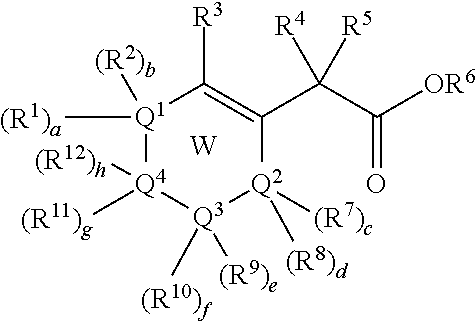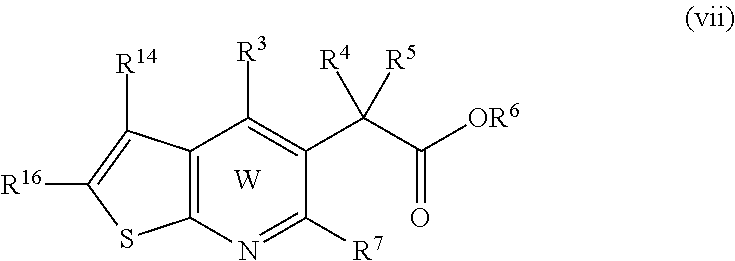Inhibitors of viral replication, their process of preparation and their therapeutical uses
a technology of inhibitors and viral replication, applied in the field of inhibitors of viral replication, their process of preparation and their therapeutical uses, can solve the problems of drug-resistant viruses, non-cure hiv infection, and significant toxicities
- Summary
- Abstract
- Description
- Claims
- Application Information
AI Technical Summary
Benefits of technology
Problems solved by technology
Method used
Image
Examples
example 1
Synthesis of 2-(tert-butoxy)-2-[2-(3,4-dihydro-2H-1-benzopyran-6-yl)phenyl]acetic acid
[0321]
Step 1: Preparation of intermediate 2-(2-bromophenyl)-2-hydroxyacetic acid (1a)
[0322]To a solution of 2-bromoacetophenone (3.0 g, 15 mmol) in 1,4-dioxane (45 mL) and water (15 mL) was added selenium dioxide (3.34 g, 30.1 mmol) and ytterbium(III) trifluoromethanesulfonate hydrate (0.61 g, 0.98 mmol). The mixture was heated at 90° C. for 18 hours. The mixture was filtered at room temperature through Celite®. The filtrate was concentrated in vacuo. To the residue was added a 0.25M aqueous solution of sodium hydroxide (150 mL). The resulting solution was extracted with dichloromethane (2×60 mL). The aqueous layer was acidified with concentrated hydrochloric acid until pH 1 and extracted with ethyl acetate (2×60 mL). This organic layer was dried over sodium sulfate and evaporated to dryness to provide 2-(2-bromophenyl)-2-hydroxyacetic acid (1a) (2.32 g, 10 mmol, 66%) as a yellow solid which was us...
example 2
Synthesis of 2-(tert-butoxy)-2-(4-cyclohexyl-2-methylquinolin-3-yl)acetic acid
[0333]
Step 1: Preparation of intermediate 2-cyclohexanecarbonylaniline (2a)
[0334]Cyclohexylmagnesium chloride (21.16 mL, 1M in methyltetrahydrofuran, 21.16 mmol) was added to a solution of 2-aminobenzonitrile (1 g, 8.46 mmol) in tetrahydrofuran (17 mL) at −10° C. over 45 minutes. Then the reaction was allowed to warm to room temperature and to stir at this temperature for 18 hours. The reaction was quenched by slow addition of a 6N hydrochloric acid aqueous solution at 0° C. and made basic by the addition of a 5N sodium hydroxide aqueous solution at room temperature. The organic layer was separated and the aqueous layer was extracted with ethyl acetate for three times. The combined organic layers were washed with brine, dried over sodium sulfate and concentrated in vacuo. The crude product was purified by flash chromatography on silica gel (cyclohexane / ethyl acetate 95 / 5) to afford the desired product (2a)...
example 3
Synthesis of 2-(tert-butoxy)-2-(4-tert-butyl-2-methylquinolin-3-yl)acetic acid
[0349]
Step 1: Preparation of intermediate 1-(2-aminophenyl)-2,2-dimethylpropan-1-one (3a)
[0350]Tert-butyllithium (13.23 mL, 1.6M in pentane, 21.16 mmol) was added to a solution of 2-aminobenzonitrile (1 g, 8.46 mmol) in anhydrous tetrahydrofuran (20 mL) at −5° C. over 30 minutes. Then the reaction was allowed to warm to room temperature and to stir at this temperature for 18 hours. The reaction was quenched by slow addition of a 6N hydrochloric acid aqueous solution at 0° C. and made basic by the addition of a 1N sodium hydroxide aqueous solution at room temperature. The organic layer was separated and the aqueous layer was extracted with ethyl acetate for three times. The combined organic layers were washed with brine, dried over sodium sulfate and concentrated in vacuo. The residue was purified by 4 preparative TLC, using cyclohexane / ethyl acetate (80 / 20) as the eluent, to afford the desired ketone (3a) ...
PUM
| Property | Measurement | Unit |
|---|---|---|
| pH | aaaaa | aaaaa |
| temperature | aaaaa | aaaaa |
| pH | aaaaa | aaaaa |
Abstract
Description
Claims
Application Information
 Login to View More
Login to View More - R&D
- Intellectual Property
- Life Sciences
- Materials
- Tech Scout
- Unparalleled Data Quality
- Higher Quality Content
- 60% Fewer Hallucinations
Browse by: Latest US Patents, China's latest patents, Technical Efficacy Thesaurus, Application Domain, Technology Topic, Popular Technical Reports.
© 2025 PatSnap. All rights reserved.Legal|Privacy policy|Modern Slavery Act Transparency Statement|Sitemap|About US| Contact US: help@patsnap.com



